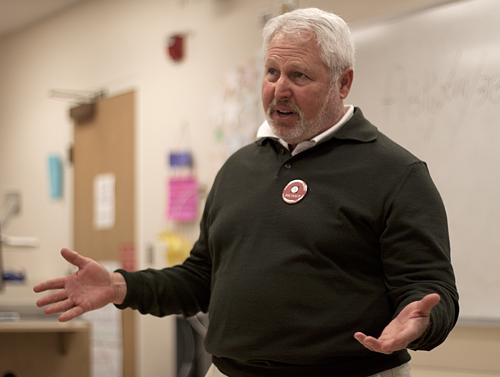Looking ahead to the upcoming fiscal year, Portland State is faced with a disparity between revenue and expenses, resulting in inevitable cuts in spending—including employee cuts. In attempts to prevent some of the anticipated job losses, PSU recently came out of negotiations with the American Association of University Professors with a plan to provide retirement incentives for eligible employees. For every employee who opts to take incentives and retire, PSU administration argues, one less position will have to be cut down the line.
PSU offers new retirement incentives to seasoned staff

Looking ahead to the upcoming fiscal year, Portland State is faced with a disparity between revenue and expenses, resulting in inevitable cuts in spending—including employee cuts. In attempts to prevent some of the anticipated job losses, PSU recently came out of negotiations with the American Association of University Professors with a plan to provide retirement incentives for eligible employees. For every employee who opts to take incentives and retire, PSU administration argues, one less position will have to be cut down the line.
“If more people retire, then you don’t have to eliminate as many positions. But at the end of the day, I don’t think we are eliminating as many positions as people may think. We aren’t spreading the cuts across the board: we’re being very strategic, trying to be clever in where we take cuts, where we don’t take cuts,” said PSU Vice President of Finance and Administration Monica Rimai.
Rimai explained the retirement incentives as being one aspect of a larger prerogative to economize PSU while maintaining the educational environment. “In the end, what we are trying to do is protect people’s employment across the entire institution. There’s no doubt that part of this is [that] it’s the right thing to do when you know you’re going to eliminate positions. Give people the opportunity to self-select,” Rimai said.
The retirement incentives in question consist of two options. The first is a one-time cash payment equivalent to 1.5 percent of the employee’s average income for three years at a minimum of $10,000 and a maximum of $40,000. The other is a medical insurance subsidy of $990 per month for a maximum of 36 months, only for the retiring employee.
Employees eligible for the retirement incentives are unrepresented or AAUP-represented employees who are at least 55 years old or have accumulated at least 30 years of retirement credit in Oregon’s Public Employee Retirement System. Eligible employees will receive notice of eligibility by late April. Those who choose to take the incentives must do so by June 7 and be retired by June 30, before the start of the next fiscal year on July 1.
The last time PSU participated in a retirement incentives package was 1996. That package consisted of health insurance subsides of $403 per month for seven years and a one-time payment of half the employee’s annual salary.
Ronald Narode, associate professor of education and vice president of collective bargaining for the PSU chapter of AAUP, explained in an email that retirement incentives need to be evaluated in the greater context of retirement with the benefits of being an Oregon public employee. Narode pointed to factors ranging from family health care expenses and tuition subsidies for dependents to an employee’s current standing in PERS.
“Everyone’s situation is different, so it is best to weigh all of the factors in addition to the very obvious factor of ‘readiness to retire,’” Narode said.
At 58 years old with 21 years of experience, Narode qualifies for the incentives, but said he’s not ready to give up teaching: “I have no interest in retiring. I enjoy my work, my students and my colleagues far too much to consider leaving. This is not a retirement incentive for me, but it may work for others.”
PSU administration would use any employee retirement as an opportunity to decrease spending, making up for vacant posts with less expensive options. A position vacated by a tenured professor or a more established employee may be backfilled by adjunct faculty or someone at the beginning of a career. In some cases, the cut positions will not be filled at all.
“There are some who would argue that it’s never worth it to do retirement incentives because it ends up costing more money,” Rimai said. “The answer is, only if you’re not careful in how you backfill, so that’s why it has to be done on a meticulous case by case basis.”
The balancing act of providing a large enough incentive to get established faculty to retire and still managing to save money will be easier to determine regarding its effectiveness after retirements are submitted on June 6. Though the AAUP agreed on the options, Narode said the incentives are too small to create much of an increase in retirement. “It is unlikely to sway anyone who isn’t already considering retirement, I believe. As for those faculty who are eligible but still have a lot to offer PSU, I would hope they remain,” Narode added.
Rimai is more confident about the projected success of the incentives: “It’s a pretty generous offer…is it as generous as other retirement incentives that are out there? No, it’s not. But is it still pretty generous? I think so. Will some people take advantage of this? Yes, we know some people will.”
Christopher Broderick, associate vice president for the Office of University Communications, pointed out that the incentives are bolstered by PERS, especially at the first-tier level, which doesn’t apply to private college retirement plans.
“At a private college, it might be more in terms of retirement incentives, but they’re not in PERS; if you’re not in PERS like PSU, that’s not nearly as attractive in terms of pension. Really, it’s apples and oranges when you’re talking about a private university and PSU when talking about retirement pensions,” Broderick said. “There’s no private retirement pension that can compare with tier-one PERS in Oregon.”





